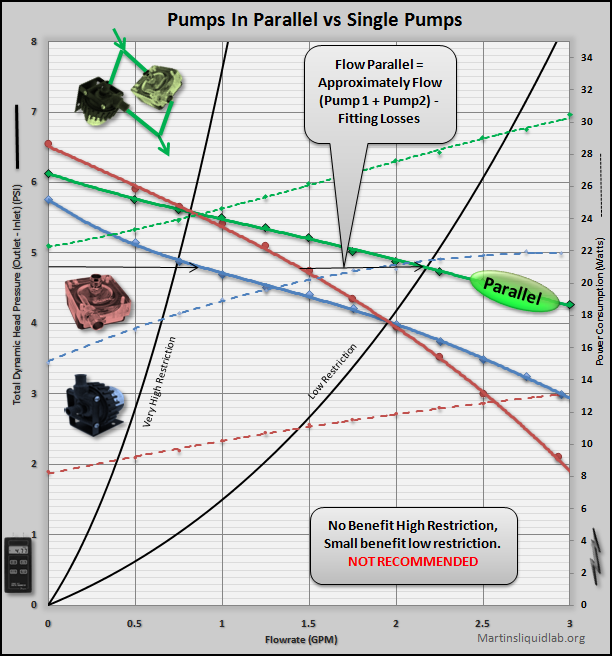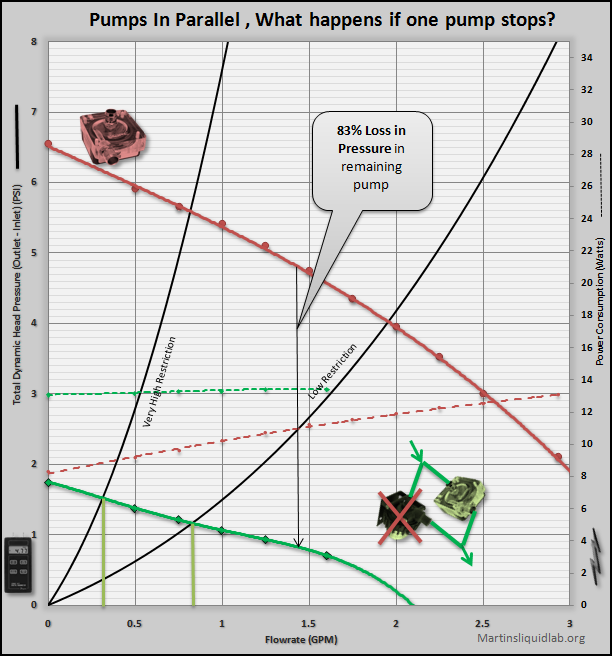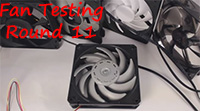While most veteran water coolers have come to accept that pumps in series is the preferred through practice, occasionally the question of series vs. parallel comes up in forum discussions. There is quite a bit of good information out there in this regard for industrial pumps, yet I haven’t seen much documented on this question with actual testing in water cooling. In an effort to provide another resource and to provide some testing to support theory and practice, I decided to test just that. I proceeded to test two pumps in series and parallel and also evaluate the redundancy result if one pump stops for safety purposes.
Before going to far, I would like to thank my many sponsors including Koolance, XSPC, DIYINHK, and Bmaverick for the pumps and mods used in this evaluation.
To test and evaluate performances, I used conventional methods of testing dynamic head pressure vs flow rate each scenario. This evaluates not only one restriction condition, but the entire range of conditions possible for a very complete look at pumping performance. I utilized a Dwyer 477-5 digital manometer for pressure differential and King Instruments 7520 0-5gpm flow meter. For voltage I used a Cen-tech P98674 measuring at the pump plug, and for amperage I used my Mastech HY3005D power supply amperage meter. In this round I skipped the RPM monitoring due to the use of two different pumps.
Note: This test is for PUMPS ONLY! Parallel vs. Series LOOPS is a whole different topic and I’m not testing that here.
There can be some benefit to parallel LOOPS under the right desired condition, but I wanted to look at pump setups under this test. THIS IS PUMPS, NOT LOOPS.. Many people for example run multiple like GPU blocks in parallel to reduce the restriction caused by the GPU blocks and emphasize more of their pumping power on the CPU block. Nothing wrong with that, but that’s parallel “LOOPS”, and this test is “PUMPS” only, make sure you understand the difference.
SINGLE PUMP TESTS
I purposely chose to use two different pumps for a couple of reasons. For starters, there is a “forum myth”, that you need to match two like pumps when run in the same loop. I believe this grows from an assumption that the impeller speeds need to match and also because of the fear that one stronger pump would “Push” the weaker pump beyond it’s abilities. Fortunately, this myth is wrong. As long as the net system flow rate does not exceed either one of the pump’s operating range, there is no problem at all with mixing different pumps. Actually, I would recommend it over two of the same because they have different noise frequencies. Due to this difference in noise output, the combined mixture of noise is smoother than putting two exact pumps together. In addition, I have experienced RPM harmonics between two like pumps where if the RPMs are extremely close, but just slightly off..you can get an undulating harmonic noise effect that can be very harsh.
I also chose two different pumps so I could more closely examine the result of pumps in series and parallel vs the single pump results. In the end, the two mixed pumps worked perfectly together, and the test results using two different pumps did find some interesting details out for me particularly the parallel test results.
Moving on, here are the individual pump curves previously tested:
Testing Pumps In Parallel
To connect the two pumps in parallel, I used some custom Y fittings fabricated out of copper 1/2″ pipe. I made these myself to represent the best possible condition for parallel. Actual usage with more conventional Y fittings would perform slightly worse than what was tested because of the added restriction. You can see the setup below:

Parallel Testing In Progress

Only small gains for low restriction setups, NOT RECOMMEND!
The result was somewhat as expected (Very Poor), but there are some interesting oddities. When you run two pumps in parallel, the curves somewhat get stacked in the X or flow rate direction with an averaging of pressure. Unfortunately this means the real gains of parallel don’t happen until you get beyond the useful restriction range of water cooling loops. On a very high restriction loop you actually don’t gain anything at all. The parallel curve crosses the single DDC curve at about the same point. On a low restriction setup you would see some gains, roughly a 22% increase in pressure, but not at all what you might have hoped for. Parallel simply doesn’t show benefits for the higher restriction levels that we typically see in water cooling and that holds true for pretty much any typical water cooling pump.
As you can see, it really doesn’t matter much which pump, the result simply doesn’t favor parallel pumps.
Beside the expected poor results, it was interesting that the parallel result is not simply adding the X direction as I thought. Max head pressure for example is not the 6.5PSI of the DDC, instead it is an average of the two pumps(6.1PSI). In the end it’s more complex than just adding the X direction, but the bottom line is that it’s not good and definitely not recommended. Parallel pump performance is poor for water cooling.
Parallel Pumps Redundancy Check
Besides performance, many folks use two pumps for redundancy purposes. On occasion, pumps do fail and the idea is that if one fails, you’ll still have one moving adequate water for cooling. Parallel is a bit unique and has raised quite a number of debates amongst forum members about this exact item.
What happens in parallel when one pump fails or quits for whatever reason?
To test this, I simply disconnected the PMP-450 and retested the parallel configuration.

DDC Single pump vs in a parallel setup with second pump off
Rather than the DDC pump pushing through the intended loop, it is now bypassing that intended loop via the PMP-450 subloop. That’s bad new for parallel loops, as you lose not only the one pump that quit, but you also loose about 83% of the remaining pump’s power.
However….it does still have “Some” pumping power left over. While it’s not going to be of any good levels, chances are your loop will still get between .3GPM and .8GPM which will function without causing catastrophic failure. In the end…it will still serve a redundancy benefit..but barely.







This article (and your site in general) has been very informative. Thank you.
I am currently in the planning stage to build my first water cooled system, and pump redundancy is important to me, though I want to keep noise– especially unpleasant noise– to a minimum.
You state that you’ve experienced harmonic issues when using similar/identical pumps at similar speeds. I take it, then, that such would not be an issue if using, for example, using identical PWM-controlled pumps with one pump advanced by five to ten percent frequency?
What effect– or would it even be advisable– do you think would be had by placing the two pumps in different parts of the loop? For example: reservoir -> pump_1 -> CPU_block -> pump_2 -> GPU_block -> radiator -> reservoir. Obviously, there would probably be an increase in restriction due to longer tubing runs (depending on where the pumps are positioned). Would the increased distance and restriction between pumps have a significant effect? I’m guessing not, as water is not very compressible and the distances are fairly short.
Again, thank you.
— A Different Justin
Hi:
How do reservoirs come into play in a setup with 2 pump in series?
If a reservoir feeds Pump A which in turn feeds Pump B, I can easily imagine the system working even with Pump B failing. Pump B becomes “passive” like a waterblock or radiator.
What happens if Pump A fails? Will Pump B be able to get enough water because instead of being fed, it has to suck in water through a dead bump plus a radiator?
Sorry. Please ignore “radiator” in the last sentence and use “reservoir” instead.
Reservoirs really only feed a pump during that initial filling of the loop. The pump needs to be primed or full of water to push fluid around. bOnce he loop is full it really doesn’t matter where the reservoir is located. At that point the reservoir is doing nothing more than storing extra volume and serving “bubble trap” duties. I have taken kit loops filled them on the bench then installed them in the system with the reservoir on bottom and pump up top and they work just fine. As long as the loop is mostly full of water location is no longer as important.
Hope that makes sense.
Thank you very much for the clarification. I’m considering having pumps in series for redundancy purposes and I just want to make sure I set it up right.
Hi martin i have a little question,
i’m upgrading my system.
my case is a corsair obsidain 700D
I had this loop:
ek reservoir 100 ->aquastream xt-> CPU -> GPU -> 140mm phobya radiator->mcr 320 qp radiator-> back to res.
i wanted to add a radiator but i think taht this would be too much for my little aquastream. So i ordered a swiftech MCR320 driverev3 (with reservoir and an mcp35x pump included).
I want to do only one loop and i thought doing that
driverev3 (at top of case) ->CPU->GPU->MCR320 (at bottom of case)->ek reservoir-> aquastream xt-> phobya 140 Radaitor (vertically on back of case) -> driverev3
So my concern is about the use of the EK reservoir, i’d like to use it juste to have a bigger quantity of water (and so more inertia because i’m using it fanless when unneeded thanks to the aquastream controller)
So i see 2 possibilities: 1st one is in the loop right before the aquastream XT, but i think that in that case i will loose the benefit of 2 pumps (or jsut to consider that each pump qill act on a more little loop)
the other option is to fix this reservoir to the driverev reservoir fill port and put it on top.of the driverev.
but as the reservoir is right in the middle of the radiator i don’t know if it would mess with the radiator efficiency.
So what do you think about the 2 solutions ?
thanks.
It is ok but the extra reservoir volume really won’t help cooling much at all. You need really large volumes like a 55 gallon drum before you really could benefit from volume heat storage.
Hi Martin,
This is a very nice article. I would expect in the setup of the pumps in series and one pump fails the performance would be somehow similar (or even worse) as if only one pump was in the loop. But the 2nd pump -even if turned off- isn’t quite a passive device. The article shows that the turned off pump amplifies the performance. Have you considered to test 3 or more pumps in series?
Hey Martin,
First of all thanks for doing this. Really appreciate everything you’ve done here.
I just had a question about whether it would be okay to run a d5 strong 12v pump with an xspc 750 bay res/pump combo in series. If so which would you suggest goes first in the loop. This is mostly because I don’t have a second reservoir to use currently and getting a new one is months away.
Thanks
Yes as long as your net system flow rate does not exceed the 750s maximum or about 1.5-2.0GPM. That pretty hard to do with an average restriction setup and guessing if you are buying a second pump that you have more than a CPU block and rad in there. I would put the 750 first and strong immediately after and below so you can prime both pumps when you first fill. If you cant do that, I would leave the strong pump off until you have filled the loop with the 750. Alternatively the newer 750s have a spare port in the back that could be used to bypass the pump and just use the reservoir as a plain reservoir. You could also just use the strong at 12v if you wanted a quieter speed range with more of a normal D5 setting 4 power level. I’m a bit of a silent freak, I like the amazing power of the strong at 24v but 12v has the sound level I like.
Thank you for the quick reply Martin. I will go ahead with what you suggested and put the D5 @ 12v right behind the 750. As I would definitely pick the the silence first as well. Thanks again, I’ve been hearing so many different suggestion but this seems to be the most ideal and appropriate for my situation.
Mixed pumps and fans draws a lot of misinformation. I think users assume a 4×4 pickup analogy where the front and rear tire sizes need to be equal. They only need to be equal because the transfer case locks the two speeds and on pavement you have a very positive friction connection. Water is completely different. Saying you have to match pumps is like saying father and son can not both paddle a canoe at the same time. The canoe is the more appropriate analogy as there is no mechanical connection between the two people and the water is also a fluid which flows freely. No harm in mixing pumps as long as the resulting system flow rate is within the max flow rate in either pump. because we have fairly restrictive blocks and parts that make mixing pumps almost impossible to do wrong. The only thing to watch for is making sure each pump is primed full of water before powering on.
Really I couldn’t thinking of better way to explain it than what you just did. The analogy shoots down every other argument against two different pumps in series and really makes it easy for the average person to understand. If only there was a way to put this information front and center so the misinformation doesn’t keep spreading as it has. Even experienced water cooling enthusiasts I’ve asked and spoken too seem to be hesitant or believe differently.
When putting two pumps in series, are there any benefits to spreading them out in the loop (filling problems aside) instead of putting them directly inline? For example, putting a pump right before the radiators and then a second pump after the radiators/resevoir to “drive” the blocks? Thanks.
Not that I’m aware of unless your tubing or clamps just couldn’t handle the 2x pressure head. Spreading would just allow restriction between to lower the max system head a bit but the net flow should be equal.
i see SXpc come out a XSPC Twin D5 Dual Bay Reservoir Acrylic . any chance you would review compares to 2 pumps setup vias tubing? Any advantage ? thank you.
They should be three pretty close or close enough. XSPC s has generally been focused on a good design for pump performance too. Most dual tops do loose a little over two separate, but it’s minor enough and two in series is a lOT of pump so no problem.
Thanks for any other great article. The place else could
anybody get that kind of information in such a perfect
means of writing? I’ve a presentation subsequent week, and I
am on the search for such info.
[…] We tested a lot of D5′s recently including the EK Single D5 Top. This version of the EK Dual top is the series version which means that the first pump outlet connects to the inlet of the second pump. This is the version we would recommend because series pumps are better than parallel pumps (according to martin’s testing here). […]